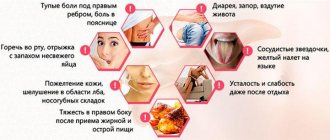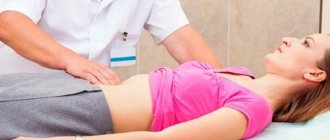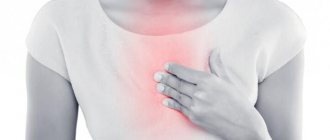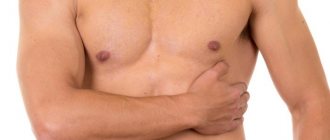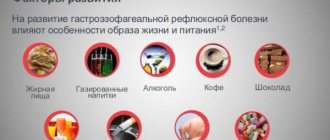What to do if your left side hurts or pulls on the left side
Many organs of the digestive system are located on the left side of a person. Therefore, most often pain in the left side is associated with their pathologies. On this side are the stomach, liver, pancreas, small intestine, large intestine and gall bladder. Based on the location of the pain, one can assume the development of certain pathologies.
When your upper side hurts, it may be due to the following:
- diseases of the stomach and pancreas, in particular gastritis, ulcers or pancreatitis;
- food poisoning. As a rule, additional symptoms include nausea and vomiting, and sometimes fever;
- dysfunction of the spleen. This usually occurs during infection or after a blow.
Pain in the left side that occurs at the waist or between the ribs may be evidence of the development of colitis. Constant tingling or throbbing pain in the lower left part of the abdomen, combined with lack of appetite and alternating diarrhea with constipation, is often a symptom of the development of oncology
When pain in the left side is localized below, this may indicate intestinal obstruction. This pathology often manifests itself as cramping painful sensations independent of food intake.
A misconception is that a symptom of appendicitis is pain on the right side. Quite often, an acute attack is accompanied by pain on the left side, which intensifies when pressed.
You should know that the left side often hurts during pregnancy. If there are no anomalies, then such painful sensations are not pathological and indicate an increase in the pressure of the uterus on the internal organs.
Any action to relieve pain on the left side can only be taken when a diagnosis has been established. Any self-medication can cause serious complications. Quite often the left abdomen hurts due to exacerbation of chronic pancreatitis. This pain occurs after eating fatty foods and may be accompanied by vomiting.
If your stomach hurts on the left side due to food poisoning, then you can relieve the pain, first of all, by gastric lavage. To do this, you need to use regular boiled water, which you need to drink at least one and a half to two liters at a time. After this, vomiting should be artificially induced. To increase the effectiveness of the procedure, it is recommended to repeat it.
After gastric lavage, it is necessary to restore the water-salt balance. To do this, you should drink at least 2 liters of liquid within 4 hours. It is recommended to add salt to the water at the rate of 1 teaspoon per liter of water.
In most cases, after such activities, the pain subsides. If this does not happen, then it is allowed to take No-shpa or Papaverine.
When your stomach hurts on the left side due to gastritis, it is strictly forbidden to decide on your own to take medications. They must be prescribed by a doctor. The most commonly used astringents are. They form a protective film on damaged areas of the mucous membrane, resulting in pain relief.
In addition, with gastritis it is very important to neutralize the effect of hydrochloric acid, which is most often a provoking factor in the occurrence of pain. For this purpose, antacids are prescribed. Such medications interact with gastric juice and reduce its acidity, which helps relieve pain.
Various pathologies and nature of pain
If discomfort occurs in the upper abdomen - the left iliac region, a common cause of such pain is problems with the heart, which is located slightly higher in the chest cavity. If aching, nagging pain in the precardiac region, which can radiate to the upper part of the anterolateral wall of the abdomen, is observed in chronic cardiac pathologies, then acute pressing, burning and stabbing pain may indicate the development of such a formidable problem as myocardial infarction.
In this case, sensations can radiate to the left arm, shoulder blade, or even lower jaw and be accompanied by shortness of breath and a feeling of fear of death. If the problem finds the patient outside the walls of the hospital, he needs to provide emergency first aid and wait for the ambulance to arrive. In addition to this pathology, stabbing pain radiating to the left hypochondrium can be observed with the following diseases:
- pericarditis;
- heart neurosis;
- cardiomyopathy;
- coronary spasm.
Diseases of the diaphragm (for example, a hernia), which directly separates the chest and abdominal cavities, can also lead to the presence of a similar symptom. However, in the very left side there are many formations that can cause pain of a similar nature.
The most serious complication of pathological changes in the spleen is its rupture. A similar condition can be caused by either a gradual increase in it or a sudden traumatic injury - in both cases there are also painful sensations. Among the factors that cause an increase in the size of the spleen and, possibly, its subsequent rupture, the following can be identified:
- inflammatory diseases of the organ;
- Infectious mononucleosis;
- splenic infarction;
- oncological processes in the body and various immunodeficiencies.
It should be noted that during delivery, organ rupture is observed in 3-4% of cases, due to excessive tension in the muscular frame of the mother’s abdomen, which can be facilitated by a physiologically determined enlargement of the spleen during pregnancy.
Regardless of the cause, this pathology requires urgent surgical intervention - the organ is usually removed.
Neurological diseases and symptoms are varied and variable. The following may be causes of tingling in the left side area:
- intercostal neuralgia, which occurs as a result of compression of the neurovascular bundles passing along the lower edges of the ribs;
- abdominal migraine is somewhat less common, but if it occurs it can cause a lot of discomfort; the pain, as a rule, occurs in paroxysms;
- pathology of nerve fibers, characterized by the occurrence of unconditional painful impulses sent to the brain.
With hormonal changes and disorders of the autonomic nervous system, stabbing pains of various localizations can also occur.
Discomfort in the left side area can be caused not only by diseases, but also by certain physiological causes. Pain can occur due to spasms, overstrain of the abdominal muscles, oxygen starvation of the diaphragm, as a result of which a spasm can also occur.
Everyone knows the feeling of tingling in the left hypochondrium after intense physical activity, especially running or other aerobic exercise. In this case, a sudden acceleration of blood circulation occurs, which causes the spleen to work more intensely and increase slightly, thereby putting pressure on nearby tissues.
Pregnant women may also experience pain along the entire left side, which is usually associated with some enlargement of the spleen and a change in the position of certain organs. In this case, if there is any discomfort, you should consult your doctor.
1. Condition after surgery in the pelvic region on the left. It can be performed to remove malignant and benign tumors, stop internal bleeding, and ectopic pregnancy. A frequent situation in the ovarian area can be the formation of cysts, which also require surgical removal.
2. Varicose veins of the small pelvis - occurs due to poor circulation and congestion in this area. At risk are people who, due to the nature of their profession, are forced to stand for long periods of time (salespeople, hairdressers, surgeons). This disease, in the case of the formation of significant venous nodes or the risk of developing thrombophlebitis, also requires surgical intervention.
3. An acute condition that can cause sharp stabbing pain in the left iliac region is apoplexy. It is characterized by sudden hemorrhage into the ovary, which leads to its rupture and the release of blood into the abdominal cavity. The reasons may lie in hormonal imbalance or neurological disorders, sclerotic changes in the organ itself. Synonyms for this pathology include such phrases as hematoma or ovarian infarction, rupture of the corpus luteum.
Men may also experience pain in the lower abdomen, including the left side of the pelvis. For example, due to adhesions, inflammation or oncology of the bladder, surgical interventions in this area.
Acute unbearable pain arising on the left under the ribs should be a reason to immediately call an ambulance. This symptom often indicates a ruptured spleen or a serious exacerbation of a peptic ulcer associated with gastric perforation or internal bleeding. With such pathologies, the pain attack is so strong that the person may lose consciousness. If internal bleeding occurs, additional vomiting of blood occurs, which does not bring relief.
A dull aching pain, present almost constantly, is caused by chronic diseases such as pancreatitis, gastritis or cholecystitis. In addition, such a symptom can accompany various inflammatory processes in the digestive system. If pain occurs periodically and is accompanied by vomiting, then most likely it indicates the development of a stomach ulcer. Sometimes such pain becomes a symptom of a pre-infarction condition or the development of angina pectoris.
Stitching pain in the left side of the abdomen, as a rule, signals kidney pathologies. This symptom can be observed due to increased gas formation for various reasons. As a rule, this causes a feeling of fullness in the intestines.
Sharp pain that occurs suddenly may indicate problems in the genitourinary system. In women, this pain syndrome occurs when the ovaries rupture or cystitis. In addition, paroxysmal abdominal pain occurs due to urolithiasis. In men, sharp or aching pain that intensifies when urinating indicates prostatitis.
Experts conventionally divide the left half of the human abdomen into several large zones: the upper - to the edge of the rib, the middle - from the edge of the 10th rib to the iliac spine, the lower - the pelvic area.
In the upper part, the heart, stomach and liver lobe are naturally located, in the middle - the spleen, pancreas, kidney, intestinal loops, in the lower part - the genitals, large intestine.
It is precisely because of the multiplicity of possible root causes that the specialist carefully collects anamnesis during the consultation: when the deterioration in well-being occurred, where the pain is felt most strongly, what is its nature, intensity, is there any irradiation of unpleasant sensations, was there a rise in temperature, vomiting, diarrhea, what unpleasant events preceded the health disorder.
This is followed by a physical examination of the abdomen - palpation, percussion - during which the specialist will examine the symptoms of pain in more detail: localization, extent, and other signs.
Methods of objective diagnostic research help to put everything in its place: ultrasound. X-rays, various blood, urine, stool tests, FGDS, CT, MRI - according to individual indications.
Many different pathologies are accompanied by pain impulses, since this is one of the most characteristic ways of the body to signal about disturbances in activity that have arisen in it.
Why colitis on the left side can only be answered by conducting a series of diagnostic studies. A preliminary diagnosis can be made by carefully analyzing the location of the pain site and its characteristics:
- Pathologies of the spleen:
- Various leukemias are oncological neoplasms accompanied by inhibition of hematopoietic function. Early symptoms include previously uncharacteristic fatigue, increased sweating, and decreased appetite. The pain syndrome appears with a significant increase in the parameters of the spleen from the initial ones, and is described by patients as a constant aching, stabbing pain in the left side;
- Blockage of the splenic arteries leads to the formation of a focus of necrosis - organ infarction. It is characterized by an intense pain syndrome, accompanied by significant fluctuations in temperature parameters and a general deterioration in well-being. Requires urgent surgical intervention;
- Inflammation of the spleen is rarely a primary pathology; it often forms as a complication of a severe somatic inflammatory pathology already existing in the body, for example, cirrhosis of the liver. In addition to intense stabbing and pressing pain in the left side, the patient experiences severe vomiting, hyperthermia, and a significant deterioration in general well-being.
- Pathologies of the intestine - its various parts:
- A disease of a congenital or, less commonly, acquired nature is malabsorption. It is based on the inability of the tissues of the small intestine to absorb one or more types of products, for example, milk. Characteristic signs include: frequent urge to have a bowel movement, cramping pain caused by increased flatulence, weight loss;
- Chronic stressful situations, an uncorrected diet, and abuse of alcohol and tobacco products can provoke a multi-symptom disease such as irritable bowel syndrome. It manifests itself as frequent attacks of pain, often on the left side, flatulence, alternating constipation and diarrhea. Characterized by the absence of visually noticeable morphological modifications of the walls of the organ;
- Nodular inflammation of intestinal loops, manifesting with severe pain in the left side, frequent diarrhea, and vomiting. An adequate diagnosis is made based on the results of diagnostic methods for examining the intestines, for example, colonoscopy;
- A polyetiological disease of a chronic nature in the large intestine is ulcerative colitis. Severe pain impulses in the left abdominal region, paroxysmal, are combined with flatulence, nausea, and vomiting. The occurrence is based on: negative hereditary predisposition, imbalance of immune structures.
Spleen lesions
The spleen is an organ that is fragile and easily traumatic. Even a light blow to the area where it is localized can provoke severe stabbing or aching pain.
Particularly dangerous is an enlarged spleen, which is not so easy to recognize due to its deep location inside the abdominal cavity. Additional difficulties can be caused by the patient's excess weight when, due to fullness, the bulging of the enlarged organ is not visible.
Since the spleen plays an important role in the functioning of the body, protecting it from infections, hemolytic anemia and viral lesions. When these dangerous diseases strike a person, in addition to stabbing pain, he may experience fever, headaches, intoxication and sore throat. Additionally, due to severe poisoning, the liver becomes enlarged.
In rare cases, discomfort may be caused by abnormal formation of the spleen and swelling. If colitis is due to the spleen, you should also carefully examine the area around the navel. When it changes color from its usual color to bluish or purple, you should urgently go to the hospital or call an ambulance. The reason for this pathology lies in the rupture of the spleen - a condition that is extremely life-threatening for the patient.
Formation of pain and its stages
The occurrence of pain is a very complex pathophysiological mechanism. With the same pathology, for example, with pancreatitis, it can be cramping, dull, stabbing, and encircling.
Painful sensations can migrate to an area very distant from the pathological focus. There are known cases of the formation of a pain impulse without a clear primary source.
The main reasons for the formation of a painful focus:
- local circulatory disorder;
- the formation of an imbalance in cellular metabolism;
- the beginning of dystrophic mechanisms;
- morphological modifications of the affected organs.
Pain syndrome develops in several stages:
- the person notes the appearance of local discomfort in the projection of the negative focus;
- if the situation worsens and there are no adequate therapeutic measures, referred pain appears, and the connection with the primary negative focus may be completely lost;
- with further expansion of trophic modifications and deepening of negative processes, a significant expansion of the source of discomfort occurs.
Only if you consult a specialist in a timely manner, will he be able to quickly conduct diagnostic tests and answer the patient’s questions about why there is colitis in the left side.
Left-sided pneumonia
A rather dangerous condition that may not manifest itself in any way until severe inflammation and the formation of an abscess in the lung.
Pathology can be suspected by rare aching and stabbing pain in the area on the left near the ribs. In this case, painful sensations can manifest themselves both in the abdominal cavity and in the back.
Gradually, the affected organ begins to release a large amount of toxins into the body, which may cause fever, chills and difficulty breathing. Since such symptoms can easily be confused with a common cold, it would not be a bad idea to undergo an X-ray examination.
Pain in the left half of the body due to other diseases
When the left side hurts, it is impossible to make a diagnosis on your own, due to the fact that the causes of pain can be very diverse. But it should be understood that any type of pain in the left side is dangerous, so it is necessary to conduct an examination, after which correct and effective treatment will be prescribed.
Attention! You should not self-medicate; it can cause harm and lead to unpredictable consequences.
First of all, when your left side hurts, you need to see a therapist. At the first appointment, he will examine and palpate (feel) the sore spot. In addition, you will need to answer many questions - this will allow the doctor to figure out what tests and studies need to be carried out first.
When diagnosing pain in the left side of the abdomen, blood, stool and urine tests are mandatory. Based on their results, the presence of foci of inflammation in the body can be detected.
An informative method is ultrasound of the abdominal and pelvic organs. If necessary, an additional computed tomography may be prescribed. This study will clarify the results of ultrasound, as well as confirm or exclude oncology.
When there is a need to examine the esophagus, stomach and duodenum, fibrogastroduodenoscopy (FGDS) is used. Using this procedure, you can examine the mucous membranes and detect areas of damage. Very often, in order to establish the cause of pain in the left side, it is necessary to undergo an examination by different specialists.
Based on the tests and examinations received, the therapist can give a referral to a gynecologist, traumatologist, surgeon, gastroenterologist or infectious disease specialist.
Pain on the left appears in many diseases and dysfunctions of internal systems.
The disease is characterized by sudden stabbing pain to the left of the sternum, which can move to the area under the ribs, radiate to the arm, shoulder or scapular area:
- angina pectoris;
- ischemic disease;
- cardiomyopathy.
Sometimes there is discomfort, tightness in the chest without clear localization, shortness of breath. The pain mainly appears at night, after physical or nervous stress, and is accompanied by an accelerated heartbeat and fear. A sign of such pain is its reduction after taking nitroglycerin and validol.
Bronchitis, pneumonia - occurs with pain in the left, right side of the chest, in the side (depending on the location of the inflammation). Painful sensations appear when the pleura is involved in the pathological process (it covers the outside of the lungs and has many pain receptors). The pain is dull, intensifies with breathing, changing body position, and is combined with cough, shortness of breath, general malaise, high fever, and wheezing. For diagnosis, an x-ray examination is performed.
Pulmonary tuberculosis can also manifest as dull, aching pain. Sometimes it is minor and feels like discomfort in the chest. Other manifestations of the disease include:
- prolonged cough;
- hemoptysis;
- profuse night sweats;
- fatigue;
- weight loss;
- pallor;
- apathy.
Pathologies of the diaphragm
Due to weakening of the diaphragm muscles due to obesity, age-related changes, constant physical activity, and heavy lifting, a hernia can form. The opening through which the esophagus passes widens. This is accompanied by intense heartburn, belching, regurgitation, pain in the sternum (more on the left or under the ribs), which imitates heart disease. There is a feeling of a lump in the throat, difficulty swallowing, which creates some discomfort while eating.
It causes pain in the left side under the rib. The pain can be either dull or severe, stabbing, “dagger-like”, simulating a heart attack. Neuralgia is characterized by increased pain with any movement, breathing, or coughing. When nerves are pinched, the pain intensifies when you press on the corresponding areas of the chest.
Injuries may be accompanied by damage to internal organs, severe pain, aggravated by breathing and movements, which is combined with a drop in pressure, a decrease in pulse, severe pallor, and a faint state.
Rheumatism, hernias, osteochondrosis occur with paroxysmal pain in the chest, radiating to the left, right side, under the rib, which simulates damage to the internal organs. The pain is constant, increases with movement (especially when bending), decreases at rest. Sometimes it resembles an angina attack. Against the background of osteochondrosis, the intercostal muscles may ache. In severe cases, their atrophy develops.
If there is pain in the back under the ribs, this may indicate kidney damage (glomerulo-, pyelonephritis, hydronephrosis). With inflammation in the kidney, the pain is dull, aching, and is not associated with the position of the body, since it occurs due to stretching of the organ capsule and radiates to the left side. Intoxication syndrome is observed (high temperature, chills, nausea, lack of appetite, weakness).
Pain in the left side may indicate gynecological pathologies:
- endometriosis;
- inflammation of the ovaries;
- cysts;
- ectopic pregnancy.
Sometimes such pain can be associated with ovulation or menstruation.
Topographically, part of the stomach is located in the left hypochondrium. Therefore, it is not surprising that with pathology of this organ, stabbing pain in this particular localization can be observed. Depending on the frequency of pain, connection with the techniques, nature and amount of food consumed, various diseases can be diagnosed.
Diseases of the pancreas can also manifest as stabbing pain in the left side. As a rule, they are expressed in case of exacerbation of the inflammatory process. In this case, this symptom is accompanied by vomiting, nausea, and increased body temperature.
If the pain extends below, directly within the left side of the abdomen, located under the subcostal region, intestinal pathology should be suspected. These may be the following diseases:
- a common and rather banal reason is the overflow of the organ lumen with feces due to chronic constipation;
- colitis - inflammation of the descending colon or sigmoid colon;
- diverticular disease;
- proctosigmoditis is an inflammatory process localized in the mucous membrane of the sigmoid and rectum simultaneously;
- helminthic infestations or significant dysbacteriosis;
- acute obstruction - may occur due to blockage of the lumen by a tumor, intestinal stenosis, adhesions in the peritoneum;
- elongation of the sigmoid colon (dolichosigma) due to congenital pathology, including Hirschsprung's disease.
Traumatic injuries to the kidneys, as well as pathologies involving their capsule in the process: urolithiasis, hydronephrosis, polycystic disease, kinking (twisting) of the ureter, its external compression (by a tumor, hematoma, scar), vascular thrombosis can also lead to the occurrence of stabbing pains in this localization.
Intercostal neuralgia
A person experiences stabbing pain due to severe compression and irritation of the nerves between the ribs.
Discomfort especially increases during sports and heavy physical work. As the disease worsens, pain begins to appear when inhaling, sneezing and coughing.
If the disease has become of this nature, you should urgently contact a neurologist to prevent further destruction of nerve endings. With intercostal neuralgia, stabbing pain can be intermittent and move to the lower abdomen, radiating to the scapula and tailbone.
At the time of the attack, the patient experiences painful pallor, redness in the area of the ribs on the left side, and increased sweating. After a few minutes, you may feel numbness on the left side.
Selection of treatment
Since pain on the left side can occur for a variety of reasons, their treatment can only be carried out after diagnosis. By eliminating the cause, it is almost always possible to get rid of pain.
Medication
The choice of drug treatment depends entirely on the type of pathology that provokes pain in the left abdomen. If pain occurs due to diseases of the spleen, then very often there is a need for urgent surgery.
To alleviate the patient's condition and relieve pain, painkillers may be prescribed - Spazmalgon, Ibuprofen, etc. If bloating is observed, Espumisan or Mezim Forte may be additionally prescribed.
Medications that have an enveloping effect are widely used. Today the most famous drug is De-nol. When pain is accompanied by heartburn, antisecretory drugs are indicated.
Painkillers from the NSAID group should be taken with caution, as they have a strong irritating effect on the gastric mucosa. In case of severe pain, you can take No-shpa or Nimesil.
Biliary colic
Biliary colic, also known as hepatic colic, can either occur suddenly or be persistent. Some patients notice that they first feel a tingling sensation on the right side, which is almost unnoticeable. But then the pricking begins to get stronger, and as a result, a severe attack of pain occurs, which is very difficult to get rid of.
Most often, biliary colic makes itself felt when the bile ducts are blocked, and the bile stagnates due to this. Then the pain can be sharp, and completely unexpected.
The sensation of tingling and pain usually occurs after a heavy meal, which is quite difficult for the body to cope with, or after physical activity. Colic can make itself felt after exercise, especially if stones are present, causing them to begin to move.
Colic almost always goes away on its own after 6-8 hours. However, until it passes, the person will be in great pain, and painkillers may not have any effect.
